|
 |
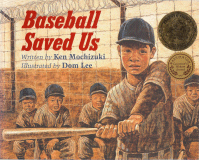
Baseball Saved Us
Lee & Low Books, 1993, ISBN 1-880000-01-6; paperback, ISBN 1-880000-19-9. Ages 6 and up.
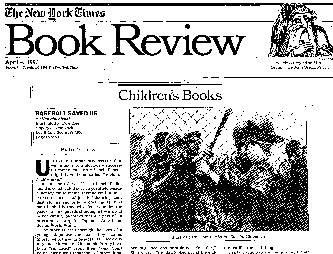
Review
of Baseball Saved Us in the New York Times Book Review
Click
here for the Baseball Saved Us Teacher's Guide
|
- Winner, Parents' Choice Award
- Winner, Washington State Governor's Writers Award
- Best Multicultural Title, "Cuffies Award" - Publishers Weekly
- "Editors' Choice" - San Francisco Chronicle
- "Choices," Cooperative Children's Book Center (CCBC)
- "Pick of the Lists," - American Bookseller
- Washington State Children's Choice Award Finalist
Summary: A Japanese American boy named "Shorty" watches with confusion and awe as he and his family are removed from their home and sent to an incarceration camp in the middle of an American desert. As social conditions start deteriorating within the camp, Shorty's father decides to lead other Japanese Americans in building a baseball field at the camp and forming baseball teams. Shorty, who wasn't a good baseball player back home, reaches a critical moment and must rise to the occasion. He also faces a similar situation during a game after the war.
"… [Mochizuki] captures the confusion, wonder and terror of a small child in such stunning circumstances with convincing understatement … the illustrations by Dom Lee … add a proper serious mood to this fine book." -
The New York Times Book Review
"Fine debuts for author, illustrator, and publisher." - Kirkus Reviews
"Powerful … the baseball heading over the fence on the last page tugs at the heart of readers as it symbolizes freedom lost, and regained." -
School Library Journal
During August 1991, I received my first phone call from Philip Lee, who tells me he has founded a children's picture book company called Lee & Low Books in New York City. He was searching across the country for authors and illustrators to launch his first set of books, and got my name through his wife Karen Chinn, a former Seattleite and colleague of mine at the International Examiner newspaper (see "About Ken" section). Up to that point, I had never authored anything in the field of children's literature, but would I be interested in writing a children's picture book? I remained open to the idea, and Philip sent me an article from an East Coast magazine about Japanese Americans forming baseball teams and playing the sport within the American incarceration camps for Japanese Americans during World War II. A non-fiction story about this subject? he suggested. I decided I wanted to make it historical fiction, and create a young hero who hits not only one home run during a clutch situation, but two!
With good reviews - particularly a write-up in The New York Times Book Review - and over a half million copies of this book later sold, my career began as a children's book author and presenter.
|

Heroes
Lee & Low Books, 1995, ISBN 1-880000-16-4; paperback, ISBN 1-880000-50-4. Ages 6 and up.
Click
here for the Heroes Teacher's Guide
|
- Teachers' Choices - International Reading Association
-
Notable Books for Children - Smithsonian
-
"Editors' Choice" - San Francisco Chronicle
-
Notable Children's Trade Book in the Field of Social Studies
-
Children's Book-of-the-Month Club Selection
-
Finalist, Georgia Children's Picture Book Award
Summary: Set during the '60s with the Vietnam war going on and World War II popular in the media, Japanese American Donnie Okada always has to be the "bad guy" when he and his friends play war because he looks like the enemy portrayed in the media. When he finally has had enough, Donnie enlists the aid of his 442nd veteran father and Korean War veteran uncle to prove to his friends and schoolmates that those of Asian descent did serve in the U.S. military.
"Dignified and effective." - The New York Times Book Review
"Once again Mochizuki and Lee adroitly focus kids' attention on a pervasive social problem by giving it an individual face; they make their points in an age-appropriate fashion, neither trivializing the issues nor condescending to their audience. Mochizuki captures his protagonist's hurt, confusion and pride - emotions capably matched by Lee's atmospheric artwork." -
Publishers Weekly
"Mochizuki and Lee tell a moving picture-book story about a Japanese American child who is treated as the enemy in his own country." -
American Library Association Booklist
"This book evocatively recreates a time when the war was still fresh in the minds of young parents, and ably shows how subtly prejudice was passed on to their children." -
Kirkus Reviews
As a follow-up to the successful Baseball Saved
Us, Philip Lee, the publisher and my editor at Lee & Low Books, suggested I do a story about the 442nd Regimental Combat Team, the all-Japanese American U.S. Army unit in World War II that became one of the most decorated units in U.S. Army history. For my first draft, the story starts out similar to the plot in the published book, but I included a flashback scene as the 442nd battles the Germans in France - soldiers shooting and getting shot at, getting wounded, sloshing around in the freezing water and snow. Philip replied: no way can there be that level of violence in a children's picture book. So, the end result was the non-violent Heroes with kids playing war.
|
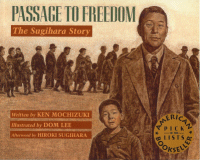
Passage to Freedom: the Sugihara
Story
Lee & Low Books, 1997, ISBN 1-880000-49-0; paperback, ISBN 1-58430-157-0. Ages 8 and up.
Click
here for the Passage to Freedom Teacher's Guide
Click
here to read Lee & Low Books "BookTalk Interview" with Ken Mochizuki on Passage to Freedom
|
-
Winner, Parents' Choice Award
-
1998 American Library Association Notable Book
-
Winner, Parenting Reading Magic Award
-
Winner, Teachers' Choices Award, and Notable Book for a Global Society - International Reading Association
-
Winner, Bulletin Blue Ribbon Award
-
Winner, Society of School Librarians International Best Books, K-6 Social Studies
-
Texas Bluebonnet Award Master List
-
National Council of Teachers of English Notable in Language Arts
-
"Pick of the Lists" - American Bookseller
-
"Editors' Choice" - San Francisco Chronicle
-
"Choices," Cooperative Children's Book Center
-
Notable Books for Children - Smithsonian
-
Notable Children's Trade Book in the Field of Social Studies, NCSS/CBC
-
Finalist, National Jewish Book Award
-
Finalist, 1999 Utah Children's Book Award
-
Finalist, 1999 Arizona Young Readers' Award
Summary: Living with his family at his consulate office in Kaunas, Lithuania, diplomat Chiune Sugihara, representing the country of Japan, is awakened one morning during July 1940 to see hundreds of Polish Jews crowded around his consulate and more still coming. Told through the eyes of oldest son Hiroki, he recounts events leading up to the agonizing decision that his father and family reached - do they help these refuges by writing them the visas they are asking for so they can escape the Nazis, even though the Japanese government has ordered Consul Sugihara not to? Or, do they not act and let these people die? The decision and act of Sugihara resulted in global-changing consequences. As the Jewish proverb at the beginning of the book states: "If you save the life of one person, it is as if you saved the world entire."
"A stirring story." - Starred Review, Publishers Weekly
"This story of honor, love, and compassion presents a view of history that is seldom found in history books. It should be purchased by every public and school library." -
School Library Journal
"Lee's stirring mixed-media illustrations in sepia shades are humane and beautiful … The immediacy of the narrative will grab kids' interest and make them think." -
Booklist
" … finely crafted creative nonfiction." - The Seattle Times
Toward the end of 1994, Yukiko Sugihara and her son Hiroki began telling their story via a photo exhibit titled
"Visas for Life" - of their husband/father who, as a Japanese diplomat stationed in Lithuania in 1940, is credited with saving over 10,000 Polish Jews from the Holocaust. Liz Szabla, then editor at Lee & Low Books, suggested I do this story as a picture book. What? Nazis, genocide, the Holocaust in a children's picture book? How? When we began to hear the story from Hiroki Sugihara's point of view as a young boy during that time, we knew we had the workable vehicle for a picture book. There was hardly any information available on this man, family and story - as opposed to now - and I thought I would have to spend endless hours in libraries and archives. Then, in November 1995, Hiroki came to Seattle to speak at a synagogue and he placed most of my research in my
hands: his self-published book of his mother's memoirs, also called Visas for
Life. That, and additional phone interviews with Hiroki, who lived in San Francisco during that time, led to this book.
|
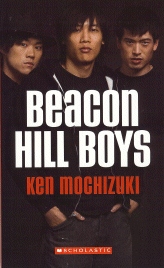
Beacon Hill Boys
Scholastic Press, 2002, ISBN 0-439-26749-8; paperback, ISBN 0-439-24906-6. Ages 14 and up
|
Summary: Set in 1972, Japanese American Dan Inagaki is a high school junior in Seattle and America is in an upheaval. The Vietnam war is still going on and Dan and his three fellow Japanese American "Beacon Hill Boys" are worried they might be drafted. Drug use is rampant. Old institutions and people are being questioned and challenged. Dan admires the African American "Black Power" movement and tries to initiate the same self-pride for the Asian American students at his high school during a time when they were fighting against being called "Oriental." Dan and his guy friends then embark on a quest for some aspect of themselves and their heritage that they can be proud of besides being part of the "model minority."
"This novel conveys the early seventies largely through the delicious music that makes life bearable for Dan and his friends; a discography at the end of the book makes it possible for readers to create their own soundtracks … While
Beacon Hill Boys is aimed at teenagers, this reviewer, who was Dan Inagaki's age in 1972, was moved and inspired thirty years later by Ken Mochizuki's story of everyday heroism." -
The Asian Reporter
"… the author nicely balances universal experiences of male adolescence - confusion about girls, parental expectations, pressure to do drugs, building a family of friends - with scenes that bring readers right into the complicated era, and his important, thought-provoking story asks tough questions about racial and cultural identity, prejudice, and family." -
Booklist
"Mochizuki evokes the period well … the author's understanding of teen conflicts and the need to forge an individual identity should resonate with a broader audience." -
Publishers Weekly
"Beacon Hill Boys is aimed at young adults, but it isn't kid stuff. Race is a major topic, and Mochizuki deals with its complexities honestly." - Jerry Large,
The Seattle Times columnist
The story that started me off as a writer (see "About Ken")! I once remarked at an elementary school in Michigan that
Beacon Hill Boys took me a total of 21 years to write (on and off with the picture books in-between). A teacher told me afterward that one of her students turned to another and said: "Forget writing - it takes too long!" Just for me it did with this particular book.
Toward the end of the '90s, my agent, Rosemary Stimola of Stimola Literary Studio and Liz Szabla, who had moved on to become editorial director at Scholastic Press, suggested that I could turn
Beacon Hill Boys into a Young Adult novel. But, some sacrifices would have to be made in order to convert it from its adult novel form, namely elimination of a lot of the sex, drugs and four-letter words. Rosemary suggested I read some of the books by Walter Dean Myers, who wrote often of African American inner-city life, yet without a single four-letter word, although the stories and dialogue still retain their power. I tried for that in subsequent drafts, and my agent was right - I didn't miss those words, but it is as if they are still there.
There are a number of themes running through Beacon Hill Boys, but I would say that one of the most prominent is that it is about the birth of the "Asian American" identity and why it needed to be established.
|
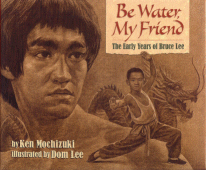
Be Water, My Friend: the Early Years of Bruce
Lee
Lee & Low Books, 2006, ISBN 13-978-1-58430-265-0. Ages 8 and up.
Click
here to read Lee & Low Books "BookTalk Interview" with Ken Mochizuki on Be Water, My Friend |
Summary: "Be water, my friend" is a quote from an early '70s television interview with Bruce Lee. The book covers his childhood and teenage years and how he came to that philosophy. A restless and hot-headed youth, Bruce Lee had no interest in school and would rather get into fights until he discovered the marital art of the Wing Chun style of kung fu and learned from the master of that style. From his master, he was taught "yielding" and "gentleness" in martial arts and, during a pivotal moment, discovers the metaphor for being like water that would guide him for the rest of his unfortunately short life.
"A fine introduction." - School Library Journal
" … an unflinching look at his troubled youth and his ultimate triumph over his own worst enemy: himself " -
The Asian Reporter
"The enlightenment of this wild child is gradual and believable, and so hopeful, as children often make mistakes and need chances at a fresh start. Older children will be inspired by this book as well as younger children, so share it in high school classrooms along with the third grade! Sepia-colored renderings from acrylic/wax scratchboard are unusual, and evocative of the time period. This beautiful multicultural biography with universal appeal packs a real one-two punch." -
PlanetEsme
"Mochizuki deftly portrays Bruce's conflict between wanting to follow his master's teachings and wanting to fight when provoked. Dom Lee's acrylic and beeswax illustrations are somber. --
The Horn Book Guide
"This lyrical picture-book biography of Bruce Lee should be very popular with fans, old and new." -
The Seattle Times
In 2003, Philip Lee, again acting as my editor, visited an exhibit in Seattle of memorabilia that pertained to the late martial arts legend Bruce Lee. He suggested I do a picture book biography of Bruce Lee. Why? was my initial reaction. He's just the perpetuator of a stereotype (all Asians know martial arts). He still prodded me to check out the exhibit, so I did. I discovered facts about Bruce Lee I didn't know: that he was born in San Francisco but grew up in Hong Kong, that he was an actor in Hong Kong movies since an infant, that he was a voracious reader and wore thick glasses since he was young, that he was into ballroom dancing before martial arts and became Hong Kong's cha-cha dance champion of 1958 and was the colony's inter-high school boxing champ that same year. When I saw the photo of him sitting on the floor and reading before his personal library consisting of over 2,500 books, that's when I was sold on doing his biography - that young readers should become acquainted with the intellectual, philosophical and spiritual Bruce Lee, that he wasn't just the superhuman fighting machine as seen in his movies.
|
Other Works
Baseball Saved Us, audio version, Live Oak Media, 2004.
"Mochizuki narrates with gentleness and a depth that comes from intimate understanding." - AudioFile
Passage to Freedom: the Sugihara Story, audio version, Live Oak Media, 1999.
"The strong emotions emerge from the dramatic reading and interpretation by Ken Mochizuki." - School Library Journal
Baseball Saved Us stage musical version, author of the "book," produced by the 5th Avenue Theatre, Seattle, 2003.
Compiled the history of Asian Pacific Americans in the U.S. military and served as interviewer for the oral history, A Different Battle: Stories of Asian Pacific American Veterans, Wing Luke Asian Museum/University of Washington Press, 1999.
Within the Silence: Share the Courage, script for performance piece about the World War II Japanese American incarceration produced by Living Voices, Seattle, 1998.
Short story "I Dreaded December 7" included in the anthology
On the Wings of Peace, Clarion, 1995.
Beacon Hill Boys, screenplay for short film, Kingstreet Media, 1985.
|
|
|






